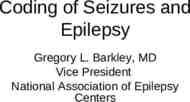1 Bench Conduct & Demeanor for Temporary Judges SUPERIOR COURT
71 Slides5.02 MB
1 Bench Conduct & Demeanor for Temporary Judges SUPERIOR COURT OF CALIFORNIA, COUNTY OF SAN FRANCISCO AUGUST 2021
INTRODUCTIONS 2
Presenters Honorable Dept. 20, Long Preliminary Hearings Honorable Dept. Ethan P. Schulman 302, Law & Motion Honorable Dept. Linda Colfax Mary E. Wiss 305, Civil Trials 3
Why are you here? To 4 satisfy California Rules of Court To ensure the public is well served - and believes it is well served To learn about available resources
Program Materials Rule 5 of Court 2.4.1 Lawyer as Temporary Judge Canon 6 Links to Ethics Resources Settlement Conference Ethics Selected Cases MCLE Certificates Evaluations
Objectives Ethical 6 rules Communication Fairness Self-represented litigants (SRL’s) Questions Break at halftime
Goals Ensure 7 visible fairness, creating trust Distinguish roles: attorney v. bench officer Describe bench officer’s obligations Sharpen issue-spotting skills Make serving enjoyable and rewarding
Don’t Be Like. “Judge Watson Vi deo” 8
Questions What did Judge Watson do wrong? Did he express any legitimate concerns? How could he have expressed them better? How could he have avoided what occurred? 9
California Code Of Judicial Ethics 1 0
Canon 6 A “temporary judge is a judge within the meaning of this Code. All judges shall comply with this Code except as provided below.” 1 1
Canon 6D 6D(1) - rules applying while presiding 6D(2) & (5) – rules specifically for pro tems 6D(6) – rule applying through final appeal 6D(7) – rule applying for 2 additional years 6D(8) & (9) - rules applying indefinitely 1 2
Canon 1 13 “ A judge should participate in establishing, maintaining, and enforcing high standards of conduct, and shall personally observe those standards so that the integrity and independence of the judiciary will be preserved .”
Canon 2A 14 “A judge shall respect and comply with the law and shall act at all times in a manner that promotes public confidence in the integrity and impartiality of the judiciary.”
Canon 3B(3) 15 “A judge shall require order and decorum in proceedings before the judge.”
Canon 3B(4) 16 “A judge shall be patient, dignified, and courteous to litigants, jurors, witnesses, lawyers, and others .”
Canon 3B(8) original text “A judge shall dispose of all judicial matters fairly, promptly, and efficiently 17
Canon 3B(8) – added text “ A judge shall manage the courtroom in a manner that provides all litigants the opportunity to have their matters fairly adjudicated in accordance with the law.” 1 8
Canon 3B(8) (Commentary) 1 9 “For example, when a litigant is self-represented, the judge has the discretion to take reasonable steps, appropriate under the circumstances and consistent with the law and the canons, to enable the litigant to be heard.”
The California Judicial Conduct Handbook 2 0
The Central Principle of Being a Judge “The basic function of an independent, impartial, and honorable judiciary is to maintain the utmost impartiality in decision making.” 21
Pillar I-Awareness of Being a Judge Always be aware that you represent the judiciary. 22
Pillar II-Mindfulness in Court 23 Be conscious of what you do and say in the courtroom. Always be attentive of what others are doing and saying in proceedings, and notice reactions, feelings, and thoughts in regard to what is taking place.
Pillar III-Rule of Law Actions and decisions in court must be within the law. 24
Pillar IV-Do Not Make Assumptions Challenge assumptions, and engage in no prejudging. 25
26 Pillar V-Professional Distance Do not take things personally, either becoming embroiled or being an advocate.
Pillar VIHonesty and Integrity Ensure honesty and integrity in the process of making decisions and in the decision. 2 7
Pillar VII-Righteousness & Courage 28 Do what is right according to law and work to have the courage to do so.
Pillar VIII-Accountability Accept and ensure judicial accountability. 29
Triggers – In and Out of Court We are subject to potentially annoying and even angering occurrences in court They may be caused by things we are not aware of Events from private life may increase our stress and affect our reactions 30
Self-Monitoring Test Scale to determine individuals’ ability to self-monitor behavior and communication in various situations. Go to: http://www2.courtinfo.ca.gov/prot em/first/scale.htm 3 1
Communicati on 3 2
Don’t Be Like. “Body Language V ideo” 3 3
Active Listening Actually 34 listen—acknowledge and focus on both speaker and message Draw out the message Communicate your understanding Encourage confirmation or clarification
Body Language Non-verbal cues Energy Open EQ vs. closed communication & social intelligence 35
3 6 Break15 minute s
What is fairness? Canon 3 7 3B 4, 8 Examples? Discuss
Fairness impartiality and appearance of that impropriety and appearance of that (I know YOU are fair!) 3 8
3 Perception of fairness just 9 as important as the reality If people don't see you as fair, it doesn't matter what you intend
Procedural fairness Feeling you have been heard Perceiving Feeling 4 0 the court as neutral respected Trusting the process
More important than winning: Understanding 4 1 the outcome—even if you don’t agree with it Having day in court - Telling story - Being heard Being treated with respect
4 2 Recognizing and Dealing with Bias
Canon 3B(5) 4 3 A judge shall perform judicial duties without bias or prejudice. A judge shall not, in performance of judicial duties, engage in speech, gestures, or other conduct that would reasonably be perceived as bias or prejudice, including but not limited to bias or prejudice based upon race, sex, gender, religion, national origin, ethnicity, disability, age, sexual orientation, marital status, socioeconomic status, or political affiliation, or sexual harassment.
Gender Identity 4 4
Sensitive to cultural/ethnic/religious differences Hats, headdress, clothing Piercings/ Looking Small 4 5 hair in the eye /meeting gaze English vocabulary More/less circumspect and not addressing issue directly Non verbal- what does a ‘smile’ really signify?
Whar Are My Biases? Involves constant reexamination 4 6
How bias is demonstrated More abrupt responses to questions Speech errors Speech hesitations Greater physical distance (pushing chair back) 4 7
How bias is demonstrated More Less frequent blinking smiling Providing Less less time for speaking open position 4 8
4 9 “WHODUNNIT Vide o”
Unconscious/Conscious Bias Much of what we do is result of unconscious & unintentional thought Looking –-and inevitably finding—data that confirms pre-conceived model of how the world is 5 0
Reaction? 5 1
How To Avoid Bias Be 5 2 conscious. Mindful. Don’t allow reasoning mind to vaporize Ask: Why am I here? What is my job? Stay cool. Imagery (mountain, ocean) Consciously confront your stereotypes
Miscellaneous Internet 5 3 Research (CJA) Judicial Ethics Committee Opinion no. 68) Burdens of Proof Standards of Review
Tips Would I make same decision if (fill in opposite- e.g., woman, White, fluent English-speaking, represented by counsel, etc.) What are my buttons, and how do people push them? Model the behavior you’re looking for Watch yourself 5 4
Tip “I can live with doubt and uncertainty and not knowing. If we will only allow that we will leave opportunities for alternatives. In order to make progress, one must leave the door to the unknown ajar.” ― Richard P. Feynman 5 5
Top Tip 5 6 “The greatest of faults is to be aware of none.” - Thomas Carlyle
Self-Represented Litigants 5 7
Don’t Be Like 5 8 “Self Represented Litigants Vid eo ”
Fairness to SRL’s Required: 5 9 recall Canon 3B(8) Language, literacy, mental and emotional obstacles may exist SRL’s may need more help But fairness giving legal advice
Suggestions With SRL’s – Level 1 Manage your calendar Tell them the procedures up front Acknowledge Let obstacles them get their case out Monitor Avoid comprehension jargon 6 0
Jargon SRL’s May Not Get 6 Plaintiff/Defendant Petitioner/ Pro Respondent per Submitted Admissible/ Sustained/ Cross Inadmissible Overruled examination Rebuttal Pleading 1
Level 2 Control repetitive testimony Show you already got the point Direct them to the next issue Directing an unfocused SRL “Help me understand ” “Tell me more about ” “Do you have the bills [or other docs] for ” 6 2
Level 3 Monitor interruptions Do not tolerate abusive language Consider hand-gesture hierarchy Use breaks Bailiffs 6 3
But - Avoid Intimidation Ignoring 6 4 Impatience Looking angry Giving orders (“Sit down. Now.”) Using needless jargon
Don’t be like “Tales of Woe Vide o” 6 5
Ex Parte communications 6 6
Ex Parte Restrictions Canon 3B(7) – limits ex parte communication (applies Canon until termination) 6D(6) – no public comment (applies through final appeal) Canon 6D8(a) – nonpublic information (applies indefinitely) 6 7
Access: ADA Request for Accommodations By Persons w/ Disabilities 6 8 California Rule of Court 1.100 Providing Accommodations while Court is in session MC 410 Form
MC410 Form Response 6 9
MC410 Form Response 7 0
Thank you! 7 1












































































